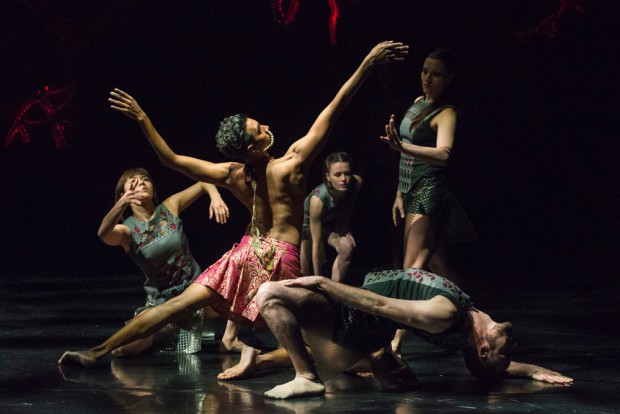For an Indian woman to make a dancework about La Bayadère is a promising prospect. This classical ballet of 1877 by Russia’s French-born genius Marius Petipa tells the simple story of an Indian temple dancer — essentially a religious sex slave — whose potential salvation by an amorous young soldier is dashed when he expediently marries the rajah’s daughter. Death and transfiguration ensue in some addictively gorgeous balletic poetry, along with all sorts of improbable exotica to please the tsar’s eye.
Londoner Shobana Jeyasingh, born in India, trained as a traditional Bharatanatyam dancer, and is a contemporary dance choreographer of keen intelligence, if sometimes letting her brain get the better of her choreographic imagination. And Bayadère — The Ninth Life is full of fascinating content.
It pivots on Théophile Gautier’s fascinated diary of the first European sight of Indian temple-dancers, in Paris in 1838, and is studded with some delicious choreography. Two weeks after seeing it, I still find certain of her lovely Indian-meets-Russian arm gestures coming back to me, homages to Petipa’s orientalist ports de bras but cleverly remade as motifs that cross from his 19th-century European eyes to her 21st-century Asian view. But what also remains is frustration that this terrific material meets a sludgy end.
The hour-long work is classically planned: tripartite, it begins by introducing us to Jas Gupta, today’s British Indian, who is recording his impressions of seeing La Bayadère for the first time. Shown simultaneously on a giant laptop screen, he blogs and tweets about its racial archetypes and Bollywood plot, noting its numerous risibilities. As he does so, through the screen, we see La Bayadère’s characters, one by one, in a speedy plot summary, Jeyasingh selecting for each of them a key motif. Here is Nikiya’s poignant gesture with her water pot, there leaps the savage fakir and the obsequious Aya, here are the rajah’s harem girls hobbled like ponies, but so prettily, in the djembé entertainment.

Jeyasingh’s evident love of this gorgeous Petipan language is clear and unforced (though I wish she had worthier dancers). But the underlying agenda starts complicating any idea of just loving the ballet stuff. In this ballet we have the rajah’s privilege to enjoy the dancing of slaves, some in blackface, some painted gold, every one a European archetype of alien inferiority.
And thus back to the era in which Petipa grew up, and Gautier’s marvellous essays on those 1838 Parisian performances by the South Indian temple dancers (which were followed by 55 more at the Adelphi Theatre in London). As Benedict Lloyd-Hughes reads Gautier’s diary entries, the woozy chuggings of Gabriel Prokofiev’s soundscape fuse the writer with La Bayadère’s famously opium-sated hero, watching supernatural dancers in a maze of wonder. Gautier exclaims at their tawny skin — ‘To touch, it is smoother than a lizard’s underbelly’ — while Jeyasingh offers a plangent passage of choreographic beauty in which our blogger is transposed in time into an Indian object of desire himself, arrayed in pearls and gold sarong, being examined and pawed by the curious crowd, his movements of wonderful Indian classical sinuousness contrasted with their earthier, modern vernacular idiom. The Petipa connection is clear, but mirrored across time.
I suppose these oil-and-water separations had to be emulsified somehow in Jeyasingh’s present language, but it’s a disappointing outcome. The stage fills with a modern choreographic muddle, without formation or spatial significance, and some unhappy physical clumsiness. The previous clarity, the insight into the different eras and geographies of this crossroads of dance, is gone in a generic awkwardness. The exploitation of temple dancers as sex slaves continues, illegally, in South India even now, but I got that from reading newspapers, not from this piece.

Scottish Ballet’s bold dance version of A Streetcar Named Desire mightily impressed me at its 2012 premiere, and its return to London last week reinforced its dramatic authenticity. Linear narrative is so uncommon at the moment that it’s all the more surprising that this was a committee job, in which previous Scottish Ballet director Ashley Page convened the far from famous Belgian choreographer Annabelle Lopez Ochoa and former Shared Experience director Nancy Meckler, a few crates and light bulbs, and the impressive Scottish dancers.
One could say much of it is very high-class mime acting, but the erotic, violent bed duet for Stella and Stanley is startlingly well choreographed, and I doubt even Kenneth MacMillan could have outdone Blanche’s awful humiliation by strangers. Central once again is the magnetic performance of Eve Mutso, a Hitchcockian blonde whose passive-aggressive gracefulness piteously incarnates the flaky Blanche. Sophie Martin’s Stella is as alluring as ever, and Erik Cavallari has become a superb Stanley — a wiry man of icy whiplash anger.
Last week, by editorial accident, Kevin O’Hare was described in my review as the Royal Ballet’s assistant director, when of course he is the director. We apologise.






Comments